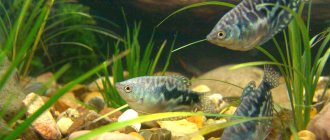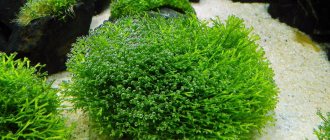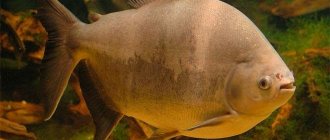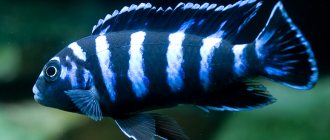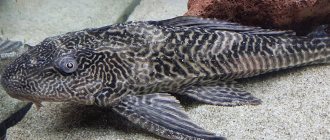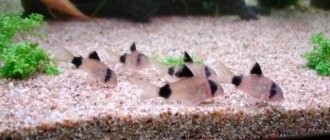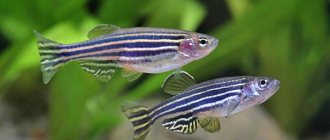The marbled crayfish is an interesting representative of aquarium crustaceans. He is unpretentious in care and food, and the behavior of such a pet is always interesting to watch. The cancer got its name due to its bright color, which strongly resembles marble patterns. In the wild, marbled crayfish live in freshwater rivers. Read more about the content of Marbled crayfish in aquarium and will be discussed in this article.
Marble crayfish
general information
Marbled or, as they are also called, Gray-spotted crayfish are representatives of decapod crayfish. They are freshwater inhabitants. The name, oddly enough, is related to their appearance. Depending on external factors, the surface of the body of crustaceans can have different colors: from black to green or even brown. The shell is decorated with a beautiful pattern reminiscent of a marble surface. And if from an early age the coloring is rather weakly expressed, then over time the contours become clearer and the cancer gets a truly marbled color.
Gray-spotted crayfish are representatives of decapod crayfish
Outwardly, it is difficult to distinguish Marbled crayfish from ordinary crustaceans living in rivers. Still the same cephalothorax , pairs of legs and, of course, claws. On average, crayfish grow up to 12 cm in length, but sometimes they can reach 15 cm. Newborn crustaceans are difficult to notice due to their small size, but they develop quite quickly and increase in size molt
Outwardly, it is difficult to distinguish marbled crayfish from ordinary crustaceans living in rivers
Note! In addition to the usual Marbled crayfish, there are also Cuban crayfish, which are distinguished by their bright blue body color.
Compatibility with fish
Marbled crayfish can be kept with fish, but you should avoid large and predatory fish that may prey on the crayfish.
For example, cichlids, some of which are simply fed with crayfish (for example, Flower Horn, you can even find a video at the link). Smaller fish are not dangerous for adult crayfish, but juveniles may eat them.
You cannot keep marbled crayfish with fish that live near the bottom, or with any catfish (tarakatum, corydoras, ancistrus, etc.), as it eats fish. You cannot keep it with slow-moving fish or fish that have veil fins, it will tear off the fins or catch the fish.
Can be kept with inexpensive livebearers such as guppies or swordtails and a variety of tetras. But sometimes he will catch them.
Shedding process:
Where do crustaceans live?
The country of origin of Marbled crayfish is the reservoirs of Germany. It was here that crustaceans were first discovered, after which they were successfully spread throughout other countries. Today, crayfish can be seen in countries such as Madagascar, Japan, the USA and some European countries.
The homeland of the Marbled crustacean is not known, but it was first discovered by the Germans in Germany
The prevalence of Marble cancer is due to its unpretentiousness. The crustacean thrives in wide ranges of water. In addition, crayfish are omnivores , making it easier for them to survive in various bodies of water.
This cancer is very unpretentious
Shedding
All crayfish molt periodically. Before molting, the marbled crayfish does not eat anything for a day or two and hides.
If you suddenly see a shell in the aquarium, do not throw it away and do not be alarmed! Cancer will eat it, it contains a lot of calcium it needs.
After molting, the crayfish is very vulnerable and you need to have a lot of hiding places in the aquarium where it can sit out.
Reproduction of crayfish
With proper care, even one individual of the Marbled Crayfish can eventually produce large offspring. The peculiarity of this species is that all individuals are females, so no fertilization is necessary for the development of embryos. At approximately six months of age, Marbled crayfish reach sexual maturity. At one time, an adult can bring from 20 to several hundred eggs . To preserve future offspring, the female must be moved to a separate tank. Otherwise, your tankmates may introduce caviar into their diet.
Reproduction of Marbled Crayfish
On a note! The incubation period lasts 4 weeks, after which small crustaceans emerge from the eggs. During this period, the cancer is always in refuge.
Immediately after birth, crustaceans can already feed on their own. Therefore, after their appearance, the adult mother must be transplanted into a separate container for about 3-4 weeks. Since crustaceans develop unevenly, it is necessary to constantly monitor them and periodically sort them. This is required to prevent cannibalism among young crustaceans.
The peculiarity of this species is that all individuals are females
But when achieving high survival rates of crayfish, aquarists are faced with a new problem - what to do with numerous offspring? Therefore, in order not to rack your brains, it is recommended to think about this in advance. Alternatively, you can start a new aquarium for small crustaceans.
Feeding
Feeding crayfish is quite simple, since they are very unpretentious creatures that eat everything they can get their hands on.
Their main food is plant matter. You need to give both vegetable tablets for catfish, various sinking granules and vegetables. Vegetables include corn, zucchini, cucumbers, spinach leaves, lettuce, and dandelions. Before feeding, vegetables are scalded with boiling water.
Although crayfish mainly feed on plant foods, they also need protein. You can feed them about once a week with fish fillets, shrimp meat, live food, snails, and pieces of liver.
Of course, you can feed only granules, but for normal molting and growth, the marbled crayfish requires a varied diet.
Are they edible or not?
There is no information about the possibility of consuming representatives of Marbled crayfish for food. This is a completely decorative species, although the body structure of Marbled crayfish is not particularly different from other crustaceans, which many people like to eat. Therefore, if you want to diversify the fauna in your aquarium , then introducing Marbled crayfish is a great idea.
Following a few simple recommendations for arranging an aquarium will allow you to acquire a nice crustacean that adorns a small marble shell. The main thing is desire and a little patience, and soon all friends and guests will not be able to take their eyes off the aquarium decorating the apartment.
See also : Mexican dwarf crayfish in the aquarium. In addition, you will probably be interested in the article about the blue Cuban crayfish.
How to fix moss, anubias, bucephalandra in an aquarium
Nitrates in the aquarium: how to reduce, check, fight and maintain
The smallest aquarium fish: types and care for them
TOP 20 most beautiful aquarium fish
TOP 12 most expensive aquarium fish
Aquarium fish that do not spawn, but give birth to fry
The water in the aquarium becomes cloudy: the reason, how to eliminate it
Heater for an aquarium. Temperature in the aquarium
Characteristics and habits
The external characteristics of the aquarium marbled crayfish are not much different from ordinary representatives of arthropods, although it is larger than its river relatives. The only difference is its unusual coloring, which looks like marble. It has a chitinous shell of a greenish-brown hue with small inclusions of black spots.
In addition, we can highlight several characteristic features that a representative of this species possesses, namely:
- Marbled crayfish grown in an aquarium can reach 15 cm in length. Young animals grow very quickly, over time growth slows down, and then stops completely.
- The color of crayfish may vary; some individuals have a green shell, while others have brown or even black. It is noteworthy that the older he becomes, the lighter his color.
- All individuals, without exception, have a characteristic marble pattern on the back; by the way, it acquires more distinct features with age.
The activity of the aquarium inhabitant begins at night, but during the day, on the contrary, it is in a state of rest. The lifespan of marbled crayfish when kept in an aquarium is approximately 15-18 months.
In an aquarium, marbled crayfish usually live no more than 1.5 years
In addition, individuals periodically undergo molting; this event occurs quite often . During this period, arthropod representatives become lethargic and timid, which confuses their breeders. Many of them get scared when they see a shed shell in a container, although this process is absolutely natural for crayfish.
By the way, you shouldn’t take the crayfish skin out of the water and throw it away. The fact is that the shed shell is an excellent food for arthropods; it saturates their body with chitin, which, in turn, strengthens their new armor.
Adviсe
- Do not overfeed individuals with protein foods, as they become aggressive.
- Install as many decorative elements as possible in the tank, pieces of wood, stones, because arthropods love to build shelters in them.
- If disease occurs, transfer the infected individual to a separate aquarium.
- Do not leave a pregnant female in a common tank, as the offspring may be harmed.
Previous
Inhabitants of the Mysterious Cherry Shrimp in your aquarium
Next
InhabitantsTactics for breeding Achatina snails and caring for eggs
Diseases
Various diseases of crustaceans are associated with improper living conditions. The presence of chemical compounds in water negatively affects the development and reproduction of individuals.
An infectious disease called crayfish plague is quite dangerous. A single sick individual can infect others, and therefore the number of inhabitants is sharply reduced. The disease is caused by the fungus Aphanomices astaci. It occurs in an acute form, paralyzing the nervous system of the arthropod. There is no cure for the virus.
Fungal spores get into the aquarium with crayfish from untreated soil. They affect the heart and blood vessels. The disease can be recognized by brown spots located on the gills. At first, the cancer becomes sluggish, and after a while it dies.
Porcelain disease causes paralysis of the limbs of arthropods: the oral apparatus is affected, the belly becomes white. It is recommended to move the sick individual to a separate container. No cure has been found for this disease.
What does marbled crayfish eat?
Marbled crayfish is unpretentious not only in maintenance, but also in food. The basis of the diet of these individuals is plant food. The following products are perfect for them:
- zucchini;
- spinach;
- corn;
- salad;
- dandelions.
Before feeding, “green food” must be doused with boiling water to remove bacteria and make it softer. In addition, you can give the crustaceans herbal tablets, which are also eaten by aquarium fish with pleasure.
Watch how the crayfish goes on the hunt for food. In addition to the vitamins contained in plants, crustaceans need proteins. Of course, this enzyme is also present in granulated food, but in order to provide individuals with a varied diet, it is allowed to give them the following food once a week:
- fillet of sea or freshwater fish;
- shrimp meat;
- snails;
- liver.
It is important not to overfeed the crustaceans, and provide protein foods in such quantities that they can consume them immediately. Otherwise, food will rot at the bottom of the reservoir, which will lead to the proliferation of pathogenic bacteria.
Keeping in an aquarium
Marble crayfish, the maintenance of which will not cause much trouble, requires a lot of space. One river inhabitant should have at least 5 liters of water. The best solution would be to purchase a 100-liter tank, which must be equipped with a lid, because it costs nothing for the crayfish to climb out of the reservoir. The aquarium is also equipped with a filter and aerator to create comfortable living conditions.
Water parameters:
- acidity – 6.5–7.5 pH;
- hardness – 8–12 dH;
- water temperature is 20–28C.
Content requirements
Basically, breeding arthropods at home is not a hassle. Marble representatives are not whimsical and omnivorous; it is enough to adhere to a few basic rules:
- Invertebrates should be kept in a spacious aquarium with a volume of about 100 liters. This is due to the fact that crustaceans are quite active and they need sufficient space so that they can move around freely.
Marbled crayfish need a fairly large space - no more than two crayfish per 100 liters
- One tank can contain no more than two representatives of arthropods.
- It is necessary to equip the container with a good filtration and aeration system; this will provide the aquarium with automated cleaning and also saturate the water with the necessary oxygen.
- Constantly monitor the water temperature; it should not be below 20 degrees and above 25; only in such an aquatic environment will the crustaceans feel comfortable.
- Every 15 days it is necessary to update the aquarium water.
- The bottom of the aquarium should be covered with sand, you can also add small pebbles.
It is advisable to have live algae in an aquarium with marbled crayfish.
- To create a natural habitat, it is necessary to place small ceramic fragments, short pieces of pipe or small driftwood on the bottom. This will allow you to create imitation shelters that the marbled crayfish will be happy to use.
- Since the main diet of arthropods consists of algae, it is necessary to start breeding these floating plants.
- An aquarium in which invertebrates are bred must be kept closed at all times. The fact is that they are easily removed from the container.
Only fulfilling all the above requirements will allow you to successfully breed aquatic pets. The correct temperature, feeding and comfortable living, similar to the natural environment, will create a favorable environment for the reproduction of marbled crayfish.
Compatibility with fish
The marbled variety of arthropods is quite capable of existing in the same aquarium with other inhabitants, although not with all. Predators, especially large ones, are quite dangerous for crustacean representatives; they often attack them. They are also incompatible with waterfowl that live on the bottom, for example, with catfish; crayfish will definitely feed on such fish.
Neighbors of the marbled crayfish should not be slow, otherwise the crayfish may feast on them
In addition, fish with veil fins should not be placed in the aquarium; as a rule, they are very slow, so they often become food for crayfish.
Swordtails, guppies and tetras can be excellent neighbors for arthropods. Such fish are very active, playful and simply incapable of causing any harm. And the slow cancer cannot catch such a nimble fish. Crustaceans can live together only with fish that are not aggressive, fearless and active.
Nutrition Basics
Marbled crayfish are particularly unpretentious in food; they are omnivores. They are mainly fed food of plant origin. Great for this:
- zucchini;
- small pieces of spinach;
- lettuce leaves;
- dandelion inflorescences;
- corn.
Any plant food for marbled crayfish must be treated with boiling water.
But before feeding the arthropods, all vegetation must be well treated. To do this, put the greens and vegetable pieces in a colander and pour boiling water over them, this allows you to get rid of all kinds of bacteria and also make the products soft. In addition, it is recommended to add special herbal tablets that are useful not only for crustacean inhabitants, but also for all other fish.
In addition to plant foods, marbled pets also need protein. That is why it is necessary to feed them at least once every 7 days with foods that contain it, namely:
- fish fillet;
- shrimps;
- liver;
- snails
It must immediately be added that arthropods should not be overfed. You need to feed only as much food as they can eat. Food, especially protein, should not be allowed to remain uneaten. Since it will simply fall to the bottom, where it will subsequently begin to rot, and this, in turn, will provoke the appearance of pathogenic bacteria.
As for the question of whether marbled crayfish themselves can be eaten, experts answer in the affirmative. Although these arthropods are mainly bred for decorative purposes, and not as a delicacy.
